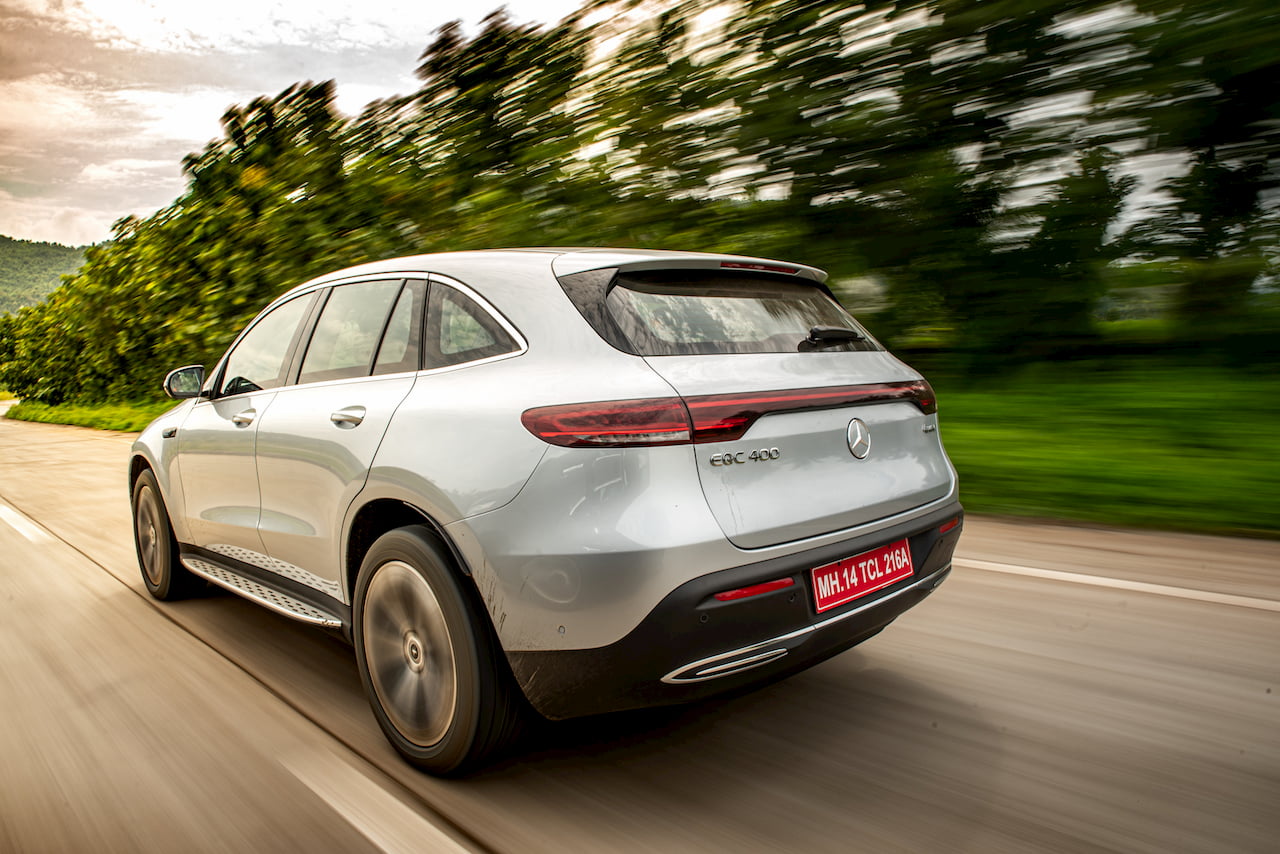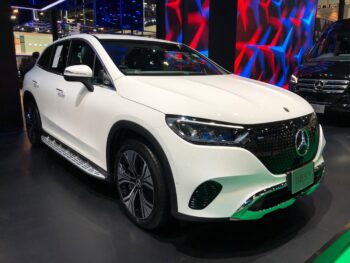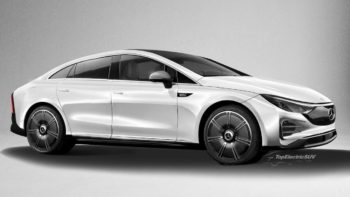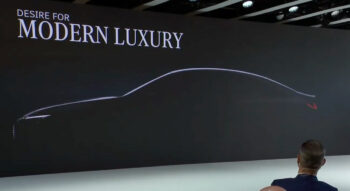Update: ‘Made in Europe’ section updated.
Mercedes-Benz is developing its all-new MMA platform, which promises to revolutionize its entry-level EVs that are currently ‘conversions’ of gasoline-powered vehicles. The new platform is designed to be flexible and adaptable, able to accommodate a wide range of vehicles at the low end of the portfolio with its electric-first design.
Exclusive to compact cars
Initially, the MMA platform’s scope was supposed to be wider than that of the EVA platform that debuted in the EQS. “The next milestone will be our future platform for the compact and mid-size classes,” Ola Källenius, the Chairman of Mercedes-Benz Group’s BoM, said about MMA at the company’s annual general meeting. “It will form the basis for numerous electric models,” he added.
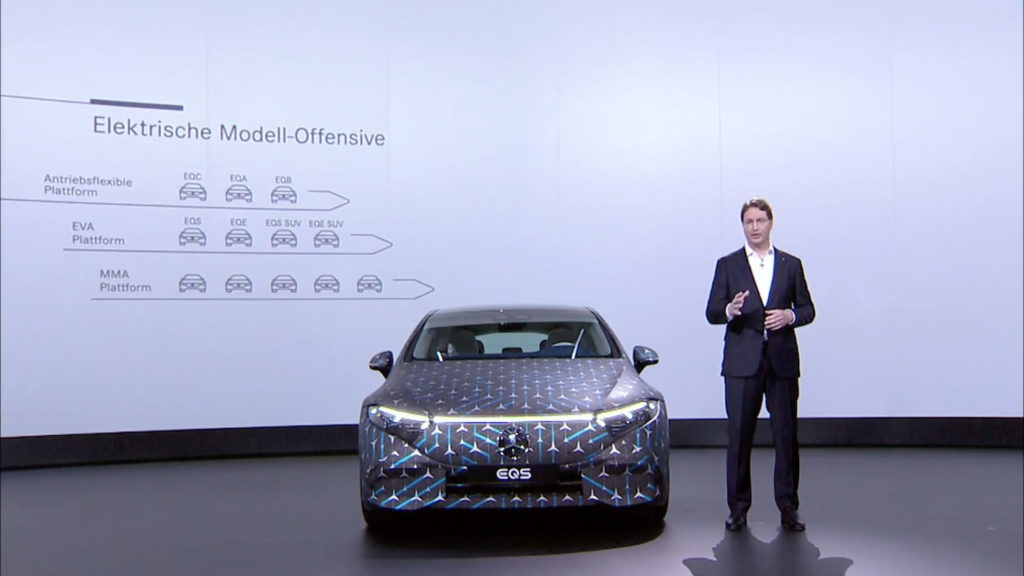
Mercedes-Benz was indicating that the MMA platform will underpin its future mid-size electric cars (equivalent to C-Class and GLC) as well. However, the company has now decided on the ‘MB.EA’ for its future mid-size and large electric cars. The Mercedes MMA platform will thus be exclusive to compact Mercedes electric car models and SUVs, such as the second-gen Mercedes EQA and Mercedes EQB. The MMA won’t be over-engineered, allowing the compact models to be affordable. Currently, the EQA and EQB share the underpinning with their respective internal combustion counterpart (GLA and GLB).
On May 19, 2022, Schafer revealed in his presentation at the ‘Mercedes-Benz Strategy Update: Economics of Desire’ event that the ‘Entry Luxury’ line-up will include only four models in the future. The company’s ‘Entry Luxury’ portfolio includes all its compact models, and there are currently seven such vehicles in the line-up: (A-Class, B-Class, A-Class Sedan, CLA Coupe, CLA Shooting Brake, GLA + EQA, and GLB + EQB). The future four models would be available with a pure electric powertrain, either as standard or as an option.
Electric-first platform
All the new Mercedes electric car launches entering production before 2025, barring the EQG, will be based on either the EVA (Electric Vehicle Architecture) platform or the MMA platform. EVA, which underpins the Mercedes EQS, Mercedes EQS SUV, Mercedes EQE SUV, and Mercedes-Maybach EQS SUV, is a bespoke EV platform. MMA, on the other hand, will be an electric-first platform.
So far, we’ve seen automakers, with Mercedes-Benz no exception, launch EVs on vehicle platforms designed for internal combustion engines. In an interview with Motor1, Christoph Starzynski, Vice President for Electric Drive, Mercedes-Benz, spoke about the new platform strategy. Unlike the EQA and EQB, the future electric variants of gasoline-engined Mercs will ride on the MMA platform that prioritizes battery-powered pure electric powertrain. Starzynski said any compromises in the MMA platform-based models would be in the ICE ones, not the electric vehicles.
The shift to the electric-first Mercedes MMA platform would allow engineers to incorporate electric vehicle-specific technologies under development. In-house developed eMotors with “sophisticated inverter and high voltage technology” and in-house battery R&D with partnerships with battery partners CATL, Farasis, and Sila Nano could bring to fruition next-generation technology that can be easily incorporated into this platform. These new materials and production processes could increase range and reduce charging time and cost.
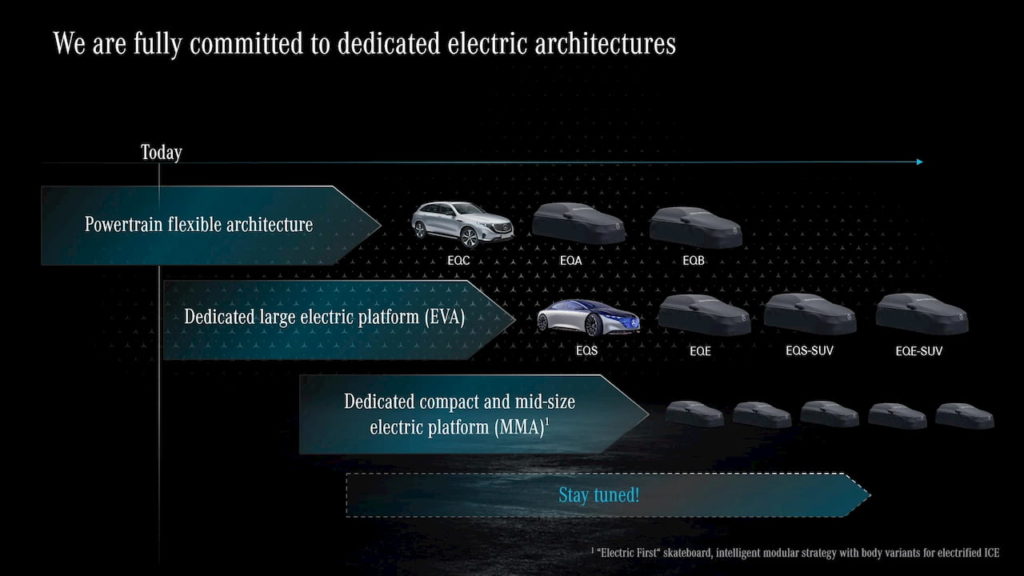
eATS 2.0 (electric drivetrain 2.0)
The electric drives for the Mercedes MMA platform models will be built in-house from 2024. Schafer has told Automobilwoche that the company wants to “master” the electric motor, battery, and power electronics. Production of the radial motors (eATS 2.0) for compact cars will take place at the Mercedes-Benz Untertürkheim plant. YASA, a British start-up Mercedes-Benz Group acquired in 2021, will build axial motors for higher performance in Berlin.
On April 18, 2022, JESMB reported that the new eATS, presumably eATS 2.0, will consist of permanent magnet synchronous motors, SiC-Inverter, a two-speed gearbox on the rear axle, and an 800-volt system.
Space
At the Mercedes-Benz Group 2021 results conference call in February 2022, Källenius had stated that all models based on the MMA platform will measure at least 4 meters 50 centimeters (177.2 in.) in length. The platform designed from the ground up favoring electric vehicles would allow engineers to generate a much higher level of room for passengers and boot space for the same footprint. The dedicated architecture also reduces the cost of manufacturing electric vehicles that offer no compromises and challenge ICE-powered vehicles in every respect.
MMA will change the dynamics of the entry-level Mercedes-Benz EVs. “This skateboard lays the foundation for everything that a successful and highly competitive EV needs: best battery location, optimized weight, aerodynamics, and great electronic and thermodynamic optimization. A fully electric platform with no compromises,” Schafer said at the Mercedes-Benz Strategy Update 2020 event.
We can fit an ICE engine in the front of the platform if we need to, for as long as the market demands it. This is a great economic equation.
Markus Schafer on the flexibility offered by the Mercedes MMA platform.
800V system
With an 800V high-voltage system, the MMA platform models should support charging speeds up to 350 kW, allowing customers to recharge in less than 20 minutes. In about three and a half years since the debut of the Mercedes EQC (September 2018), the first mass-production Mercedes-Benz EV, DC fast-charging rates have nearly doubled from 110 kW. The Mercedes EQS that premiered in April 2021 allows charging with up to 200 kW with direct current. A 15-minute charge can provide a range (WLTP) of up to 300 km (186 miles).
Last year at our strategy update, we told you about eATS 2.0, an in-house developed and built motor that will be key to the forthcoming MMA architecture. eATS 2.0 will have an outstanding performance, as part of an 800-volt powertrain with a silicon carbide inverter. eATS 2.0 is a radial permanent magnet motor, designed for the majority of our key products.
Markus Schafer, Chief Technology Officer, Mercedes-Benz (Mercedes-Benz Strategy Update: electric drive 2021)
Next generation battery
MMA platform models will feature Mercedes-Benz Group’s next-gen batteries with varying chemistries. The report JESMB published on April 18, 2022, suggested that the company will reportedly use LFP batteries with low cobalt content in MMA-based EVs. The German automaker wants to increase energy density up to 900 Wh/l in the future. Right now, the best it can do is more than 550 Wh/l, which allows a gross energy content of 111 kWh.
With our next battery generation, we will vary the chemistries within the battery to provide the best solution depending on the customers’ need in different markets. These chemistry variants will be available in our forthcoming platforms.
Sajjad Khan, former Chief Technical Officer, Mercedes-Benz AG (Mercedes-Benz Strategy Update: electric drive 2021)
Solar roof
Mercedes-Benz Group says that it is integrating many of the Mercedes Vision EQXX’s features and developments into production starting with its MMA platform. One of the features going into production is a solar roof. MMA platform-based EVs could come with this feature as an option. Schafer told journalists after the concept’s world debut that the company will probably start putting solar panel roofs in series production vehicles in 2024, as per an Autoblog report.
Level 3 autonomous driving
MMA platform-based Mercedes cars will be capable of Level 3 autonomous driving. However, it won’t be that the MMA platform itself will have to be credited for the capability. The second-gen MRA platform-based S-Class and the EVA platform-based EQS already offer Level 3 autonomous driving with Drive Pilot to customers in Europe. The MMA platform cars could offer enhanced functions, though, as Mercedes engineers can improve the Drive Pilot’s functioning and features over the next two years. MMA platform-based Mercedes models could be capable of hands-free driving at speeds of up to 120 km/h (75 mph).
Mercedes-Benz Group lists 7 benefits of the MMA platform
- Exceptional range
- Benchmark high-power charging (800V)
- High-energy efficient drivetrain and vehicle
- Exceptional calmness and comfort
- State-of-the-art digital experience (OTA capability)
- Competitive drivetrain costs
- Optimized investment and cost structure
MB.OS to debut in an MMA Platform vehicle
Mercedes-Benz Group is working on a new vehicle software to achieve independence on the software front and accelerate the development of EVs. Called Mercedes-Benz Operating System (MB.OS), this software will debut in a Mercedes MMA platform car in 2024.
The vehicles of our entry-luxury MMA platform will be based on the MB.OS software architecture for the first time in 2024. They will feature many innovations that stem from the tech program behind the Vision EQXX. As part of this, we are refocusing our portfolio and reducing at the same time, complexity. We aim to achieve this with a smaller number of alternatives. Instead of seven, we plan to offer four models in this segment.
Markus Schafer, Chief Technology Officer, Mercedes-Benz (Mercedes-Benz Strategy Update: Economics of Desire on May 19, 2022)
“With this (operating) system (MB.OS), Mercedes-Benz has the central control of all vehicle domains and thus the interfaces to the customer, who is always the focus of our activities,” Sajjad Khan told Automobilwoche. Khan was the CTO of CASE (Connected, Autonomous, Shared & Services, Electric) at Mercedes-Benz. Developing its own software enables Mercedes to achieve faster and more regular updates.
In Sindelfingen (Germany), where Mercedes-Benz Group manufactures the S-Class and EQS, it has 3,500 developers from the areas of autonomous driving or electric powertrains already working on MB.OS. In June 2021, the company said that it will create 3,000 new jobs for developing MB.OS worldwide, and most of them will probably be in Germany. The recruitment will be in the field of software programming and development.
Made in Europe
Mercedes-Benz Group has confirmed that its Rastatt plant (Germany), which is its lead compact car factory, and its Kecskemét plant (Hungary), which is an important link in its global compact car production network, will build the MMA platform-based cars. Production of the future Mercedes electric models based on the electric-first platform will start in 2024.
Mercedes-Benz Group will manufacture core components for the MMA models in Europe. Batteries will come from Kamenz and Brühl, both located in Germany. The Untertürkheim plant in Germany will produce the electric drive units for the MMA models starting in 2024. The company plans to double the production capacity of EDUs at this factory to one million units that year. European production of EDUs will take place in Sebes, Romania, as well.
Beyond MMA: MB.EA, AMG.EA & VAN.EA
The MMA (2024 launch) will be Mercedes-Benz Group’s last new platform that supports ICE as well. From 2025, the company will introduce EV-only platforms, which are MB.EA, to cover medium to large-size passenger cars, AMG.EA, a dedicated performance electric vehicle platform, and VAN.EA for purpose-built electric vans and light commercial vehicles.
Following the launch of MMA, the compact electric first architecture in 2024, all new Mercedes-Benz vehicle architectures will be electric only.
Britta Seeger, BoM member – Marketing and Sales, Mercedes-Benz Group and Mercedes Benz AG (Mercedes-Benz Strategy Update: electric drive 2021)
The end of the internal combustion engine at Mercedes-Benz may come sooner than 2039. At the Mercedes-Benz Strategy Update: electric drive on July 22, 2021, it announced that it will go all-electric in markets where conditions allow them to in 2030. However, going carbon neutral is not just about making emission-free models, it also involves converting production processes for the vehicle and its parts emission-free.
Mercedes-Benz Group says that all its European plants responsible for cars and vans will switch to CO2-neutral power supplies by the end of 2022. The Factory 56 in Sindelfingen, Germany, will serve as a blueprint, where the Mercedes S-Class and Mercedes EQS production takes place CO2-free since the rollout of the first unit (2 September 2020).
Mercedes-Benz Group to spend EUR 60 billion between 2022 and 2026
On December 2, 2021, Mercedes-Benz Group announced the approval of the Mercedes-Benz Business Plan for 2022 to 2026. It will invest more than EUR 60 billion (USD 64 billion) in Mercedes-Benz to launch new emissions-free and software-driven cars. Mercedes-Benz is preparing to go all-electric by the end of the decade, and it will mainly focus on electric mobility. The company is taking cost-cutting initiatives to bolster this transformation.
Engines for MMA models could be ‘M252’ three- and four-cylinder units shared with Volvo and Lynk & Co. That’s according to a report from auto motor und sport, which also says that these may replace the current engines supplied by the Renault-Nissan-Mitsubishi Alliance.
